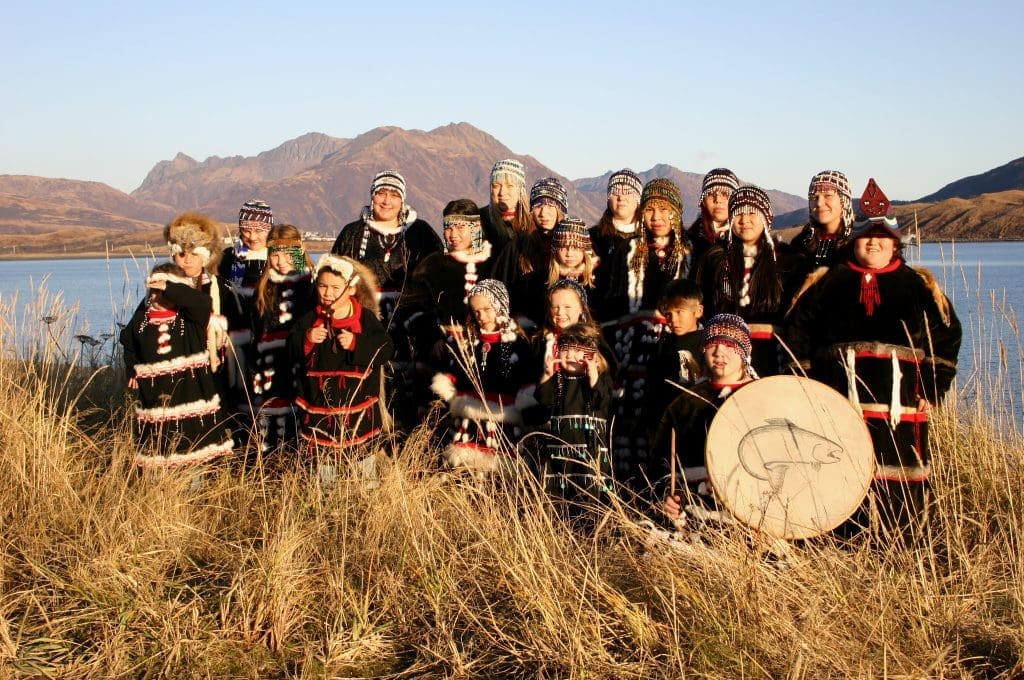
The name "Alutiiq" is a legacy of Western colonization. Russian traders called our people Aleut, a term they used for Native people throughout coastal Alaska. In our Native language, we said this word as Alutiiq. The original name for our people, however, was Sugpiaq. It means the "real person." Today all three names- Alutiiq, Aleut, and Sugpiaq are used by the Native people of Old Harbor.
Archaeological evidence indicates that our ancestors have lived in the Kodiak region for at least 7,500 years. Hundreds of archaeological sites preserve our heritage and illustrate the dynamic history of our culture. Alutiiqs have long thrived on the rich resources of the coast, harvesting quantities of sea mammals, fish, shellfish, birds, and of plants. These resources fed our ancestor’s families for thousands of years and provided resources for all the necessities of daily life.
In late prehistoric times, Alutiiq people lived in sod houses, known as ciqluaq (barabara in Russian). These dwellings were built partially underground and had a driftwood frame, plank walls covered with sod and a thatched roof. These warm, insulated homes provided protection against Kodiak’s wet, windy weather. On average, a ciqlluaq accommodated about eighteen residents; which generally consisted of related families. There was a center room connected by low openings to private side chambers used for sleeping, storage, and steam bathing (maqiq in Alutiiq or banya in Russian).
The productive marine environment surrounding Old Harbor supported a vibrant culture of hunters, fisherman and artisans. People traveled and hunted by foot on land and with qayat (kayaks) and angyat (large open boats) on the ocean. Boats had a wooden frame that was covered with skins stitched together with animal sinew. Over many generations, builders perfected the design of the qayaq and angyaq producing boats that were fast, light, and extremely seaworthy. Men hunted whales, seals, sea lions, and sea otters for food and used inedible parts for raw material to make tools and clothing. Sea lions provided skins for angyat and the qayaq. Their meat and blubber were used for food and fuel for oil lamps, and their bladders and intestines were used to make waterproof clothing.
Women gathered bird eggs, shellfish, seaweed and other edible plants, roots and berries for food. They also cleaned and dried fish and constructed and maintained the kamleikas, waterproof garments stitched of marine mammal intestines.
Museum collections, oral history, and contemporary artists reveal skill in carving, basket making, and clothing production as well as a strong heritage in song and dance. Hats and baskets were woven from local beach grasses and from spruce root traded around the archipelago. Baskets were woven with geometric patters and are considered among the finest in the world with up to 2,500 stitches per square inch. Woman also wove items such as cords, cables and fish line from plant fibers and animal tissue. The skins of seal, sea lion, sea otter, bear, birds, and squirrels were all used to make clothing. Due to the wet maritime climate waterproof clothing was essential. The garments made of skin and gut and were sewn with extraordinary precision making them very effective against the wet weather. Some of the clothing was decorated with colorful natural dyes, feathers, puffin beaks, and carved ivory figurines.
In the Alutiiq culture early winter was a time for elaborate celebrations and ceremonies. Singing, dancing and feasting were a central part of Alutiiq rituals, which commenced after winter food supplies had been gathered and stored. Drums were played to accompany song and dance. Traditionally, the drumhead was made from seal hide, seal bladder or halibut stomach. Some drums were painted with figures representing shamans' spirit helpers, while others had carved and painted handles.
Old Harbor is an area rich in culture with spiritual ties to the land, bonds of kinship and belief, respect for Elders and community and the shared practices of a subsistence lifestyle. Old Harbor Native Corporation's shareholder Dr. Sven Haakanson, Jr., who previously served as the Executive Director of the Alutiiq Museum in Kodiak, has helped to preserve and share much of the area’s history. The Alutiiq Museum collects artifacts in a professionally staffed repository and leads heritage programs that involve people of all heritages in the exploration and celebration of Alutiiq language, arts, and culture. The museum is open year round and offers a variety of changing exhibits, events, programs, and a store with locally produced artwork. To learn more, please visit the museum on line at http://www.alutiiqmuseum.org
Alaska's Konyag Country by Yule Chaffin, Trisha Hampton Krieger, Michael Rostad. Pratt Publishing. 1983.
Appeasing the Spirits, Alaskan Coastal Cultures by Jill Oakes and Rick Riewe. Beta Shoe Museum, Toronto, Ontario, Canada. 2004.
Black Ducks & Salmon Bellies by Craig Mishler. The Donning Company Publishers, Virginia. 2003.
Community of Old Harbor- Community Plan by Elders, Adults & Teens of Old Harbor. 2005.
Crossroads of Continents, Cultures of Siberia and Alaska by William W. Fitzhugh and Aron Crowell. Smithsonian Institution Press. 1988.
Handbook of North American Indians by William C. Sturtevant. Smithsonian Institution Washington. 1984.
Looking Both Ways, Heritage and identity of the Alutiiq People by Aron L. Crowell, Amy F. Steffian, and Gordon L Puller. University of Alaska Press, Fairbanks, Alaska. 2001.
Russian America: The Forgotten Frontier by Barbara Sweetland Smith and Redmond J. Barnett. Washington State Historical Society, Tacoma, Washington. 1990.
S. Haakanson (personal communication, March 3, 2008)
The Cape Alitak Petroglyphs by Woody Knebel. The Donning Company Publishers, Virginia. 2003.
The Evolution of Complex Hunter-Gatherers, Archaeological Evidence from the North Pacific by Ben Fitzhugh. Kluwer Academic/Plenum Publishers, New York, Boston, Dordrecht, London, Moscow. 2003.
The Native People of Alaska by Steve J. Langdon. Greatland Graphics, Anchorage, Alaska. 2002.